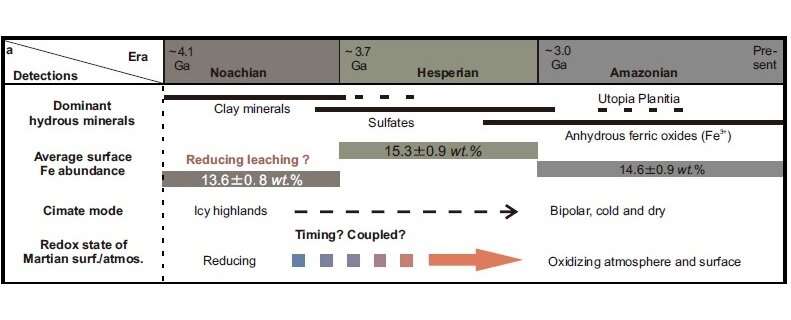Like Earth, Mars was formed about 4.5 billion years ago, but its early surface was very different than today’s. Mars’ surface then had high rates of meteorite and asteroid impacts from the period known as the Late Heavy Bombardment. But whereas today’s Mars is cold, arid, has two icy poles, with an oxidizing atmosphere—where, for example, iron-rich materials develop rust—early Mars was characterized by icy highlands, episodic warmth and a reducing atmosphere.
The cause of the climactic transition has been unclear. Now a research team from China finds evidence that atmospheric oxidation led to Mars being cold and bipolar in its early history. Their work is published in Nature Communications.
The Noachian is an early time period on Mars with high rates of asteroid impacts and possibly the presence of an abundance of surface water. The exact interval is uncertain, but the Noachian era is probably between 4.1 and 3.7 billion years ago. It was followed by the Hesperian era, 3.7 to 3.0 billion years ago.
Evidence emerging in recent years suggests that early Mars had a carbon dioxide (CO2) dominant atmosphere with reducing gases like hydrogen. In a reducing atmosphere, oxidation is prevented by the absence of oxygen and other oxidizing gases, and a reducing gas such as hydrogen, carbon monoxide and methane will readily snap up any oxygen and, in the case of hydrogen, turn into a phase of water.
A reducing atmosphere can create a strong greenhouse effect, which may have played a significant role in the warming of early Mars. As the intensity of greenhouse warming is closely tied to the presence of reducing gases, the oxidation of the atmosphere then would have resulted in the cooling seen today. (The greenhouse effect on Mars today is only about 8°C, compared to about 33°C on Earth.)
The Mars Odyssey Gamma-ray spectrometer is a measuring instrument that resides on the 2001 Mars Odyssey spacecraft, which has been orbiting Mars since 2001, returning data on the geology of the top 30 cm of Mars’s surface, such as the location of water and identifying elements.
Earlier research had revealed that surface iron abundances in terrain identified as belonging to the Noachian era was relatively low compared to terrains of the Hesperian era (3.7 to 3.0 billion years ago) and the Amazonian era (3.0 billion years to today), as well as the global surface average iron abundance.
Why was the iron abundance of early Mars low compared to the last 3 billion years? The evolution of the planet’s crust doesn’t explain it. It might have been caused by liquid water on early Mars, which could have carried some iron below the spectrometer’s 30 cm depth range, as the mobility of iron is affected by temperature, acidity, water chemistry and the redox state, which is the oxidation state of an element that determines its chemical behavior. These might have determined the distribution of iron abundance on the surface of Mars, especially if the atmosphere had a role.
With colleagues, Jiacheng Liu of The University of Hong Kong examined the distribution of surface iron on ancient Mars in both space and time, using results from the Mars Odyssey spectrometer. They found that the abundance of iron decreased with elevation in early Mars, during the older Noachian era, but decreased with latitude in more recent Noachian terrains.
Why this difference?
The group used the global geologic gap of Mars to determine the relative surface age in grids laid out on the surface, and the relative iron abundance. These data gave a better understanding of the relationships among the redox transitions and climate mode transitions.
“Our finding suggests that the surface temperature of Mars gradually evolved from an elevation-dominant to a latitude-dominant mode, coupled with atmospheric oxidation during the Noachian period,” they wrote.
One of the group’s suggestions is that icy weathering and “low temperature conditions contributed to surface iron depletion, likely facilitated by anoxic leaching through freeze-thaw cycles under a reducing atmosphere.”
Leaching is a process that’s widely used in extractive metallurgy, where pure metals are processed out of their natural mineral deposits (ores). (An example is smelting in a blast furnace to produce pig iron, which is used to make steel.)
Further analysis led them to posit that, although low pH levels (below 3) of water can mobilize iron, acidic leaching cannot fully explain the iron depletion across an extensive region of Mars’ surface. The decrease in the intensity of iron leaching from the Early to Late Noachian suggests a gradual atmospheric oxidation; as Mars’ atmosphere oxidized, its greenhouse effect decreased, ultimately leading to the cold and dry planet seen today, with ice at both poles.
“The oxidation of Mars’ surface and atmosphere drove Mars to become cold with migration of ice from highlands to polar regions,” said Liu. He points out that some scientists think the periglacial environment—the Mars subsurface below the thick cryosphere, which combines stable, long-term liquid water and heat—could be habitable for life.
More information:
Jiacheng Liu et al, Atmospheric oxidation drove climate change on Noachian Mars, Nature Communications (2024). DOI: 10.1038/s41467-024-47326-0
© 2024 Science X Network
Citation:
Atmospheric oxidation and the creation of modern Mars (2024, October 14)
retrieved 14 October 2024
from https://phys.org/news/2024-10-atmospheric-oxidation-creation-modern-mars.html
This document is subject to copyright. Apart from any fair dealing for the purpose of private study or research, no
part may be reproduced without the written permission. The content is provided for information purposes only.

